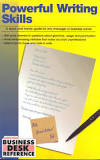Think Differently About Your Blog

“Organize and present your ideas with a targeted reader in mind,” advises Richard Anderson in Powerful Writing Skills. “Don’t be satisfied with putting down data and results or observations and opinions. Find a way to make this information meaningful to your reader.”
That doesn’t mean you should talk down to your readers, Anderson cautions. Think of your readers as being just as intelligent and sincere about their jobs as you are about yours. (Even if they aren’t, he points out with tongue in cheek, they’ll appreciate you assuming they are.) Respecting readers helps them see you as intelligent and well-informed, so try to imagine, Anderson adds:
- what they might ask you
- what they might object to
- what they might already know
- what they might find interesting
In blogging for business, of course, there’s a fifth thing to try to imagine: what you want the reader to DO as a result of reading your post. Each business blog post should impart one new idea or call for a single action. Focused on one thing, your post has greater impact, since people are bombarded with many messages each day. Respecting readers’ time produces better results for your business.
Not only must you as a writer think differently about your reader, you must think differently about your subject, Richard Anderson stresses. Imagine you’re writing a memo or a letter. Studies show that readers respond positively to memos and letters that contain a sense of the writer’s enthusiasm, Anderson points out. That doesn’t mean announcing your excitement, he adds – let the subject speak for itself.
When you blog, you verbalize the positive aspects of your business, reviewing the benefits of your products and services, constantly providing yourself with training about how to talk effectively about your business. In communicating the information to others, you can end up thinking differently about yourself!



 Want to pick up the kazoo? Start with Rule No. 1, advises
Want to pick up the kazoo? Start with Rule No. 1, advises  “There’s a unique recipe that goes into coming out ahead in just about anything,”
“There’s a unique recipe that goes into coming out ahead in just about anything,”
Follow us online!